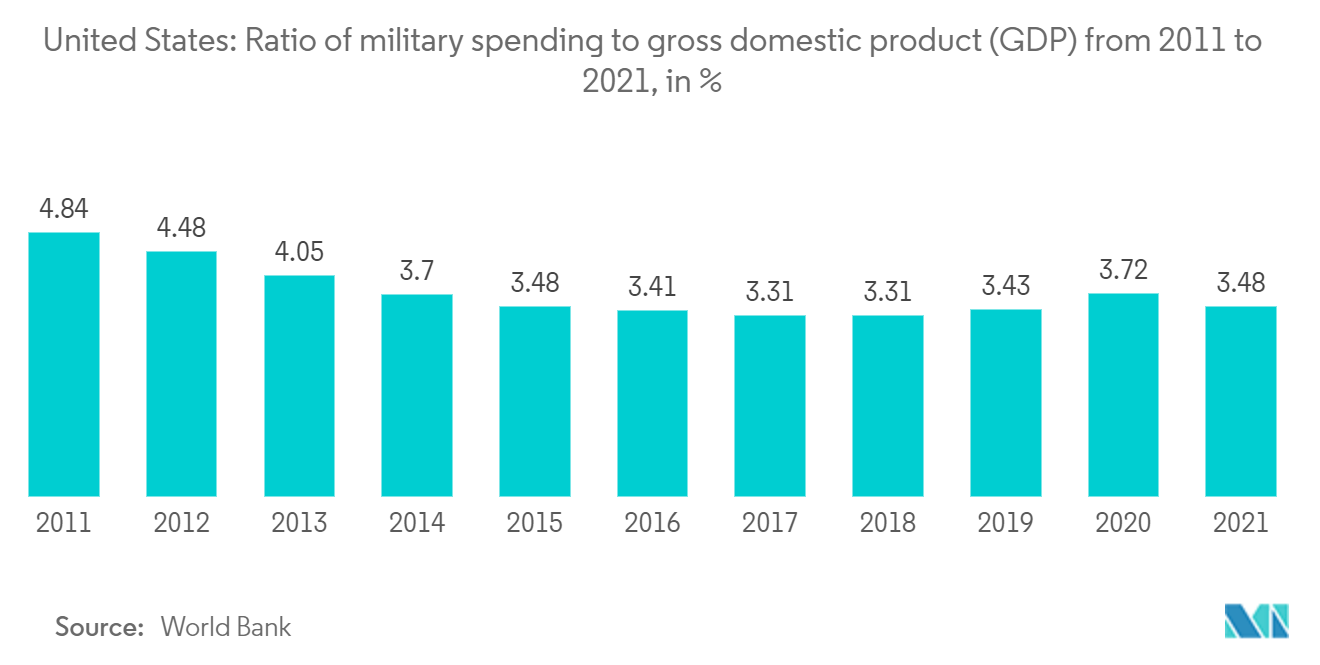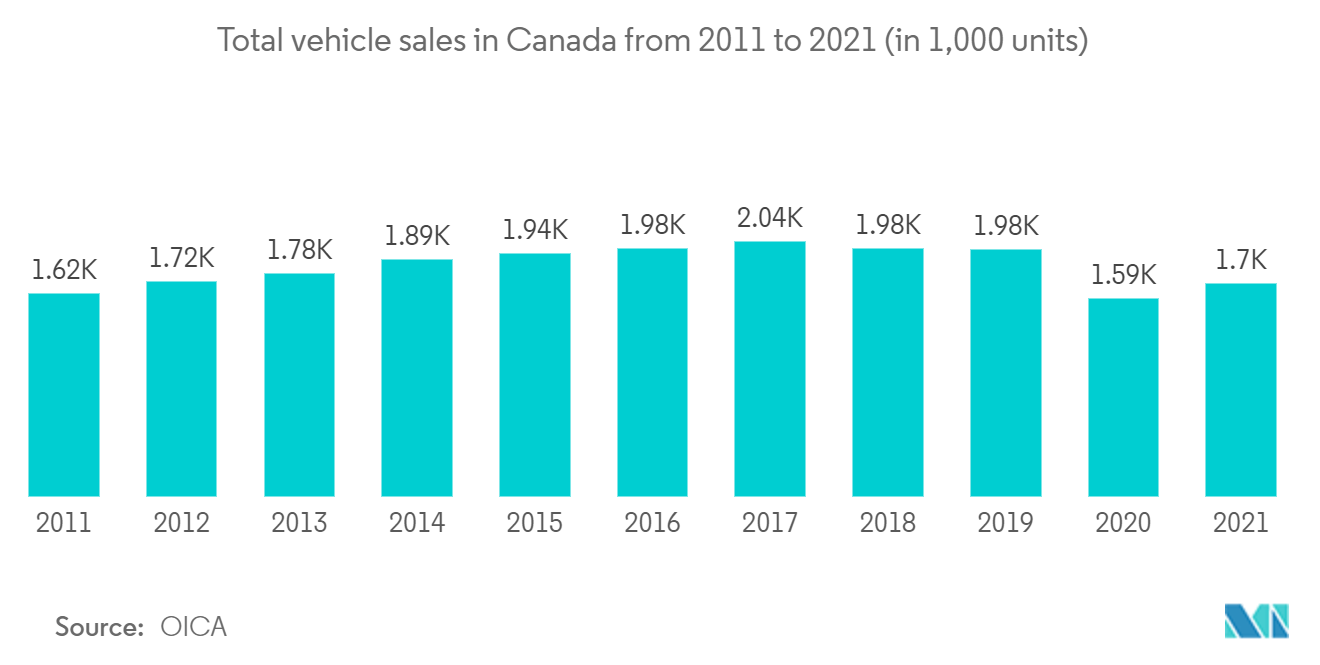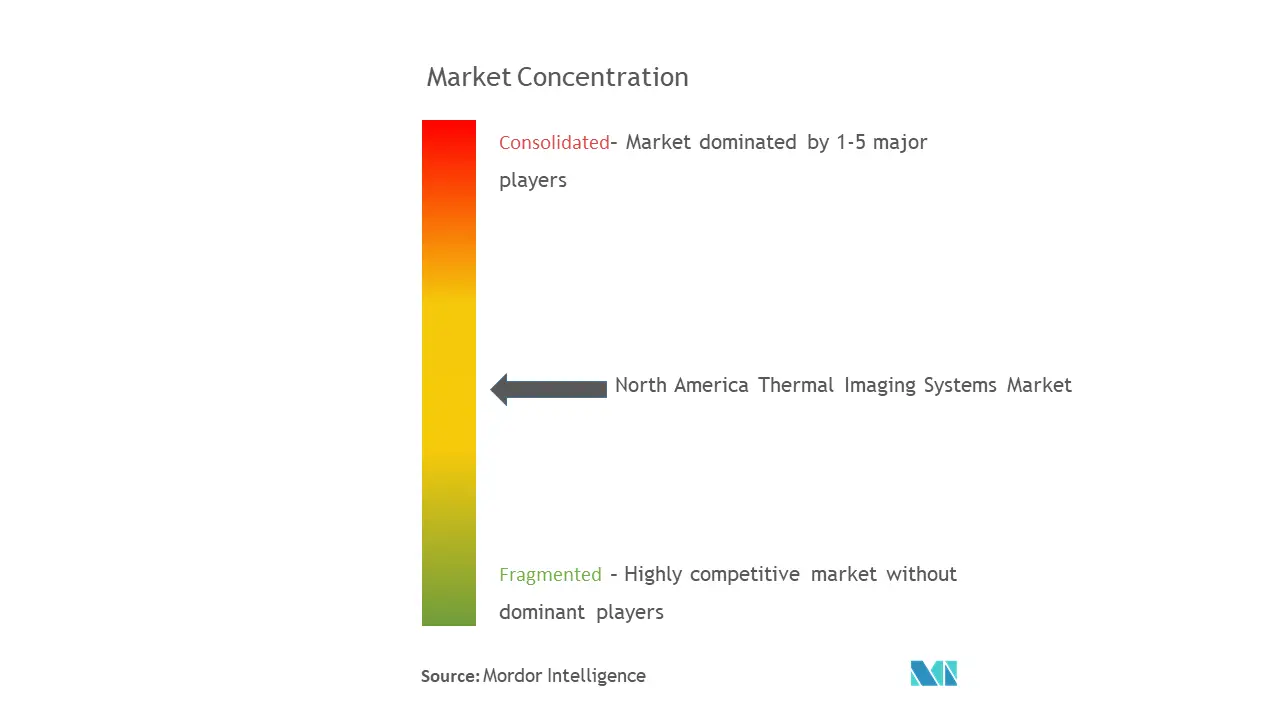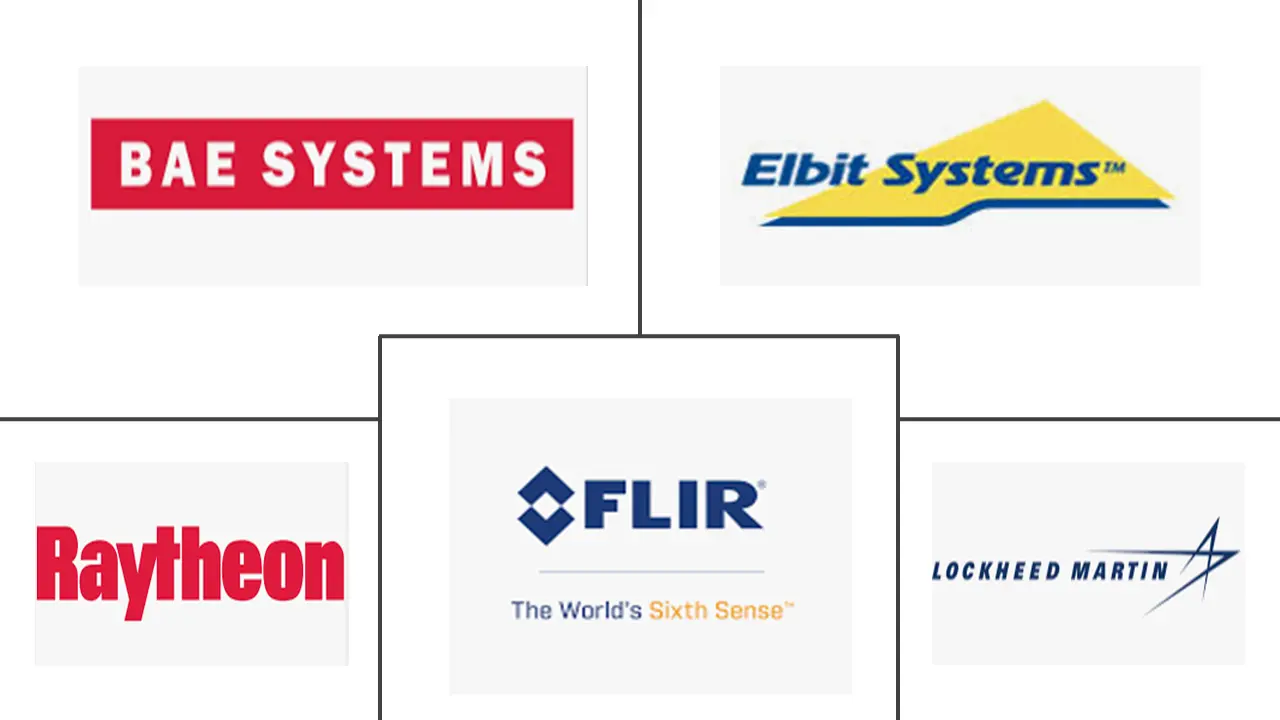
NA Thermal Imaging Systems Market Analysis by Mordor Intelligence
The NA Thermal Imaging Systems Market is expected to register a CAGR of 6.1% during the forecast period.
- The advent of smartphones as cost-effective handheld/portable thermal imaging devices is expected to increase technology adoption. Caterpillar (Cat) companies have integrated FLIR's thermal imaging camera in the Cat S60 and the latest Cat S61 smartphones.
- The United States is involved in various international activities, including peacekeeping missions and assisting foreign governments. As the United States becomes involved in various minor engagements and skirmishes worldwide, appropriate technology to defend the troops becomes increasingly critical.
- The US and Canadian soldiers have fought in the dark and under challenging conditions. Thus, even small advances in technology may make a significant difference. Thermal imaging technology has aided armies in combating the enemy and terrorists in the dark, allowing them to neutralize the danger.
- Thermal imaging is an example of a technology that began in military applications and is now employed in various industries. Thermal imaging is transforming the world with uses spanning from military to personal portable cameras and cellphones. Though it has a wide range of applications, some connected to saving lives have proven to be game-changers. These devices have grown more compact, user-friendly, and capable of producing high-resolution pictures.
- Increased demand for IR cameras is driven by factors such as the growing need for surveillance across a wide range of industries, the continual reduction of thermal camera costs, and the rapid development of high-speed infrared cameras. Inaccurate measurements and picture color problems associated with cameras are posing a threat to the industry's growth. The military and defense industries, as well as vehicles, rely heavily on infrared cameras.
NA Thermal Imaging Systems Market Trends and Insights
Military and Defense Sector is Expected to Drive the Market
- Thermal imaging systems have witnessed a paradigm shift in recent years due to their increasing use in military and defense applications. The army and navy popularly use it for border surveillance and law enforcement. It is also used in ship collision avoidance and guidance systems, whereas in the aviation industry, it has greatly mitigated the risks of flying in low light and night conditions.
- The military and defense industries were among the first to use infrared and thermal imaging devices. With the defense sector's increased investment in surveillance, the use of infrared and thermal imaging equipment is projected to grow.
- Governments all across the region are investing in next-generation technology by giving better and more accurate information to military troops. The use of IR thermography equipment in the military industry has grown, influencing the rise of infrared cameras, particularly short-wavelength IR cameras.
- There is a significant trend of increasing crime and violence in the region. As a result of this element, the budgets of the homeland security forces have increased in order to purchase advanced protection systems and devices. With an expanding number of non-lethal and deadly weapons, modern combat has grown increasingly asymmetric. The US spends more money on its military than any other country.
- To cope with diversely asymmetric, multi-dimensional and highly lethal imperatives of the battlefield, global armies are modernizing their military arsenal and getting soldiers geared up with the latest in combat and surveillance technology. Motion detection is one of an important element of Automatic Target Recognition (ATR) and perimeter monitoring systems. Thermal imaging has become an integral part of these systems because of its ability to operate in all weather conditions.
- The major application of handheld thermal imaging is increasing with the defense and security sector. The US Army is aiming to provide thousands of new goggles to its soldiers engaged in combat missions. Recently, in March 2021, the IAVS goggles are being developed by the US Army for close-combat forces. IAVS system can integrate with troops' weapons through a rifle-mounted thermal imaging night vision scope. According to Defense Visual Information Distribution Service (DVIDS), the new goggles will help enhance infantry troops' situational awareness.

Thermal Imaging is Being More Widely Used in Vehicles
- The automobile industry is gaining traction with high-tech autonomous cars, also known as advanced driver-assistance systems (ADAS) or driverless vehicles. Multiple sensors, including thermal cameras, radio detection and ranging (RADAR), light detection and ranging (LIDAR) sensors, and proximity sensors, substitute drivers in these cars to enable automated driving, navigation, and better situational awareness.
- To increase night vision and identify people or animals in foggy, crowded areas, and foggy situations, thermal imaging cameras are integrated into driverless cars, which instantly stop the vehicle to avoid any casualties.
- Thermal imaging cameras are used in the automobile industry to allow drivers to see in harsh lighting and weather situations to avoid accidents and assure safety. Automotive manufacturers and thermal imaging solution suppliers are working together to develop innovative thermal solutions for the automotive industry.
- Thermal imaging technology is also utilized for non-destructive inspection of automotive parts and micro-components to assure vehicle safety while saving time and money.

Competitive Landscape
North America's thermal imaging systems market is partially fragmented and consists of several major players. Some major players, like FLIR, Bae Systems, Elbit Systems Ltd., Raytheon Co., L-3 Communications, are already present in the thermal imaging systems market. However, with innovative solutions, many companies are increasing their market presence by securing new contracts and tapping new markets.
- May 2022 - Teledyne Technologies' Teledyne FLIR Defense received a new five-year contract of USD 500.2 million for delivering advanced thermal imaging systems to the US Army. The company would deliver the thermal imaging systems for the Family of Weapons Sights-Individual (FWS-I) program.
NA Thermal Imaging Systems Industry Leaders
-
Flir Systems, Inc.
-
BAE Systems plc
-
Elbit Systems Ltd.
-
Raytheon Company
-
Lockheed Martin Corporation
- *Disclaimer: Major Players sorted in no particular order

Recent Industry Developments
- April 2022 - Teledyne FLIR, part of Teledyne Technologies Incorporated, launched the Boson+ with thermal sensitivity of 20 millikelvin (mK) or less, making it the most sensitive longwave infrared (LWIR) camera in the market. Improved thermal performance, coupled with market-leading reliability, may help the company provide its customers with the ideal uncooled thermal module for integration in unmanned platforms, handhelds, security applications, thermal sights, and wearables.
- January 2022: Xenics launched the Ceres T 1280, a new high-performance, high-resolution thermographic long-wave infrared (LWIR) camera. Xenics is expanding its high-performance thermographic camera line with the Ceres T 1280.
NA Thermal Imaging Systems Market Report Scope
Thermal imaging detects a long IR range of electromagnetic spectrum invisible to the human eye using special and sophisticated cameras called infrared imagers. Thermal imaging lets users detect objects or individuals in complete darkness and difficult and distinct conditions. Unlike the other methods, thermal imaging works in environments without ambient light. Like near-infrared illumination, thermal imaging can penetrate obscurants like smoke, fog, and haze.
The North American thermal imaging systems market is segmented by solutions (hardware, software, services), product type (fixed thermal cameras, handheld thermal cameras), applications (security and surveillance, monitoring and inspection, detection and measurement), end user (aerospace and defense, automotive, healthcare and life sciences, oil and gas, food and beverages), and country.
The market sizes and forecasts are provided in terms of value (USD million) for all the above segments.
| Hardware |
| Software |
| Services |
| Fixed Thermal Cameras |
| Handheld Thermal Cameras |
| Security and Surveillance |
| Monitoring and Inspection |
| Detection and Measurement |
| Aerospace and Defense |
| Automotive |
| Healthcare and Life Sciences |
| Oil and Gas |
| Food and Beverages |
| Other End Users |
| United States |
| Canada |
| By Solutions | Hardware |
| Software | |
| Services | |
| By Product Type | Fixed Thermal Cameras |
| Handheld Thermal Cameras | |
| By Application | Security and Surveillance |
| Monitoring and Inspection | |
| Detection and Measurement | |
| By End User | Aerospace and Defense |
| Automotive | |
| Healthcare and Life Sciences | |
| Oil and Gas | |
| Food and Beverages | |
| Other End Users | |
| By Country | United States |
| Canada |
Key Questions Answered in the Report
What is the current NA Thermal Imaging Systems Market size?
The NA Thermal Imaging Systems Market is projected to register a CAGR of 6.1% during the forecast period (2025-2030)
Who are the key players in NA Thermal Imaging Systems Market?
Flir Systems, Inc., BAE Systems plc, Elbit Systems Ltd., Raytheon Company and Lockheed Martin Corporation are the major companies operating in the NA Thermal Imaging Systems Market.
What years does this NA Thermal Imaging Systems Market cover?
The report covers the NA Thermal Imaging Systems Market historical market size for years: 2019, 2020, 2021, 2022, 2023 and 2024. The report also forecasts the NA Thermal Imaging Systems Market size for years: 2025, 2026, 2027, 2028, 2029 and 2030.
Page last updated on:
NA Thermal Imaging Systems Market Report
Statistics for the 2025 NA Thermal Imaging Systems market share, size and revenue growth rate, created by Mordor Intelligence™ Industry Reports. NA Thermal Imaging Systems analysis includes a market forecast outlook for 2025 to 2030 and historical overview. Get a sample of this industry analysis as a free report PDF download.



